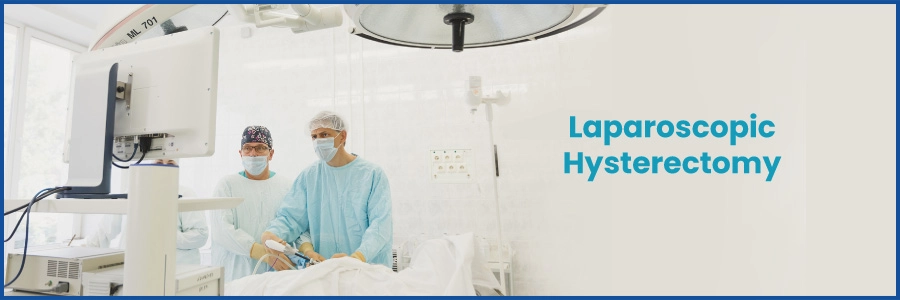Categories
- Cardiology 84
- Dermatology 45
- Endocrinology 33
- ENT 16
- Fertility 190
- Gastroenterology 78
- General-Medicine 81
- Gynecology 80
- Hematology 19
- Infectious-Diseases 33
- Neurology 52
- Oncology 34
- Ophthalmology 23
- Orthopedics 69
- Pediatrics 31
- Procedure 23
- Public-Health 144
- Pulmonology 59
- Radiology 8
- Urology 68
- Wellness 161
- Woman-and-child 77

Everything You Need to Know About Laparoscopic Hysterectomy
A laparoscopic hysterectomy is a minimally invasive surgical technique used to remove the uterus.
This procedure involves making a small incision near the belly button to insert a tiny camera, which allows the surgeon to perform the surgery while viewing the images on a screen.
Additional small incisions are made in the lower abdomen to insert specialized instruments for the removal process.
Some women may choose to keep their ovaries to avoid hormone replacement therapy and prevent hot flashes, while others may opt to remove them due to a family history of ovarian cancer or the presence of abnormal growths.
Secure your health with a second opinion. Make informed decisions and book your appointment today!
Get A Second OpinionTypes of Laparoscopic Hysterectomy
Laparoscopic Supracervical Hysterectomy
In a laparoscopic supracervical hysterectomy, the cervix is left intact. This option often results in a quicker, safer surgery, but it may cause monthly spotting.
Total Laparoscopic Hysterectomy
In a total laparoscopic hysterectomy, the entire uterus and cervix are removed, ensuring no future menstruation. This is recommended for those with precancerous changes in the cervix or uterine lining.
Why is a Hysterectomy Performed?
Healthcare providers may recommend laparoscopic hysterectomies for various conditions, including:
- Abnormal or heavy vaginal bleeding unresponsive to other treatments.
- Severe menstrual pain unmanageable by other methods.
- Uterine fibroids (non-cancerous tumors) causing symptoms.
- Pelvic pain associated with the uterus and unresponsive to other treatments.
- Uterine prolapse causing urinary incontinence or bowel issues.
- Cervical or uterine cancer, or precancerous conditions.
- Endometrial conditions such as hyperplasia, recurrent polyps, or adenomyosis.
Ready to take control of your health journey? Book your appointment now and start your path towards wellness today!
Book an AppointmentProcedure
During the surgery, the surgeon uses a camera and specialized tools to detach the uterus. The uterus is then removed in pieces through the small incisions or the vagina. This minimally invasive approach allows for faster recovery compared to traditional methods.
Precautions Before the Procedure
- Medication: Continue taking your usual medications unless advised otherwise.
- Bowel Preparation: You might need to follow a liquid diet (soups, jellies, juices) for 24 hours before surgery to empty your bowels.
- Avoid Smoking: And contact your doctor if you show signs of illness before surgery.
Recovery Period After Laparoscopic Hysterectomy
- Post-Surgery: You'll wake up in the recovery room, feeling sleepy for a few hours. Shoulder pain is common but should resolve in a day or two.
- Discomfort: Some discomfort or tiredness is normal for a few days. Consult your doctor if pain or nausea persists or worsens.
- Activity: Avoid heavy activities or exercise until fully recovered. Normal activities can typically resume in about three months, though full recovery may take longer.
- Symptoms: Expect some vaginal discharge for several days. Post-surgery, menstruation will cease, and conception will no longer be possible. Be aware of potential bladder and bowel issues.
Risks and Complications
As with any surgery, there are associated risks, including:
- Anesthesia complications
- Injury to internal organs
- Bleeding and infection
Seek medical help immediately if you experience:
- Fever
- Offensive vaginal discharge or heavy bleeding
- Severe nausea or vomiting
- Inability to empty bladder or intestines
- Severe pain
Side Effects of Laparoscopic Hysterectomy
- Menstruation: It will stop for women who haven't reached menopause.
- Conception: It becomes impossible after a hysterectomy.
- Estrogen Levels: May drop if ovaries are removed, leading to early menopausal symptoms.
Short-Term Risks
- Blood loss and risk of blood transfusion
- Damage to surrounding areas (bladder, urethra, blood vessels, nerves)
- Blood clots in legs or lungs
- Infection
- Side effects related to anesthesia
- The need to switch to an abdominal hysterectomy from one of the other techniques
Long-Term Risks
- Pelvic Prolapse: Rare risk of pelvic organs dropping into an abnormal position, especially in women with a history of pelvic surgeries or relaxation.
Conclusion
Laparoscopic hysterectomy offers a less invasive option for treating various uterine conditions, with benefits like quicker recovery and less discomfort.
However, it's essential to be aware of the associated risks and side effects. Always consult with your healthcare provider to understand the best approach for your individual needs.
By being informed and prepared, you can ensure the best possible outcome for your health and well-being.
Frequently Asked Questions
A hysterectomy is a significant surgical procedure involving the removal of the uterus, ovaries, fallopian tubes, and cervix.
In the first few days after the procedure, you may experience pain and discomfort in your lower abdomen, along with possible shoulder pain.
It's normal to experience bloody vaginal discharge in the days or weeks following a laparoscopic hysterectomy as part of the healing process.
Risks and side effects can include major blood loss, damage to surrounding tissues (bladder, urethra, blood vessels, nerves), blood clots, infection, anesthesia-related side effects, and intestinal blockage.
No, because the uterus is removed during the surgery, making pregnancy impossible.
It usually involves smaller incisions, less pain, faster recovery, and fewer complications.
Yes, but they are small and usually fade over time. They are less noticeable compared to traditional surgery scars.

Categories
- Cardiology 84
- Dermatology 45
- Endocrinology 33
- ENT 16
- Fertility 190
- Gastroenterology 78
- General-Medicine 81
- General 6
- Gynecology 80
- Hematology 19
- Infectious-Diseases 33
- Neurology 52
- Oncology 34
- Ophthalmology 23
- Orthopedics 69
- Pediatrics 31
- Procedure 23
- Public-Health 144
- Pulmonology 59
- Radiology 8
- Urology 68
- Wellness 161
- Woman-and-child 77